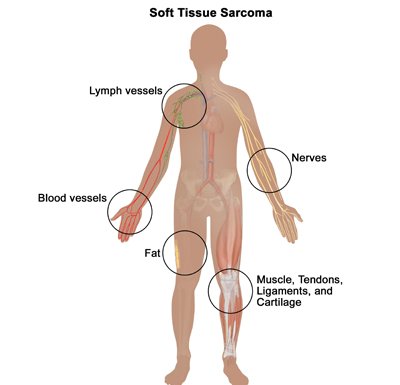
Soft tissue is defined as the supportive tissue of various organs and the nonepithelial, extraskeletal structures exclusive of lymphohematopoietic tissues. It includes fibrous connective tissue, adipose tissue, skeletal muscle, blood/lymph vessels, and the peripheral nervous system.
Embryologically, most of it is derived from mesoderm, with a neuroectodermal contribution in the case of peripheral nerves.
Soft-tissue tumors constitute a large and heterogeneous group of neoplasms. Traditionally, tumors have been classified according to histogenetic features. (Fibrosarcoma, for example, is categorized as a tumor arising from fibroblasts.) However, histomorphologic, immunohistochemical, and experimental data suggest that most, if not all, sarcomas arise from primitive, multipotential mesenchymal cells, which in the course of neoplastic transformation differentiate along one or more lines.
Thus, a liposarcoma appears to arise from a lipoblast but may actually develop through lipoblastic differentiation of a precursor multipotent mesenchymal cell. At the clinical level, soft tissue tumors are classified according to various parameters, including location, growth pattern, likelihood of recurrence, presence and distribution of metastases, patient age, and prognosis.
Although most soft tissue tumors of various histogenetic types are classified as either benign or malignant, many are of an intermediate nature, which typically implies aggressive local behavior with a low-to-moderate propensity for metastasis.
Current achievements in the field of soft-tissue tumors are the result of advances in molecular biology, oncogenetics, imaging techniques, immunochemistry, diagnosis by fine-needle aspiration (FNA), surgical reconstruction, radiation therapy, and tissue banking.
Types of soft tissue sarcomas
Adult fibrosarcoma usually affects fibrous tissue in the legs, arms, or trunk. It is most common in people between the ages of 20 and 60, but can occur in people of any age, even in infants.
Alveolar soft-part sarcoma is a rare cancer that mostly affects young adults. These tumors most commonly occur in legs.
Angiosarcoma can develop either from blood vessels (hemangiosarcomas) or from lymph vessels (lymphangiosarcomas). These tumors sometimes start in a part of the body that has been treated with radiation. Angiosarcomas are sometimes seen in the breast after radiation therapy and in limbs with lymphedema.
Clear cell sarcoma is a rare cancer that often develops in tendons of the arms or legs. Under the microscope, it has some features of malignant melanoma, a type of cancer that develops from pigment-producing skin cells. How cancers with these features start in parts of the body other than the skin is not known.
Desmoplastic small round cell tumor is a rare sarcoma of adolescents and young adults, found most often in the abdomen.
Epithelioid sarcoma most often develops in tissues under the skin of the hands, forearms, feet, or lower legs. Adolescents and young adults are often affected.
Fibromyxoid sarcoma, low-grade is a slow growing cancer that most often develops as a painless growth in the trunk or arms and legs (particularly the thigh). It is more common in young to middle aged adults. It is also sometimes called an Evans' tumor.
Liposarcomas are malignant tumors of fat tissue. They can develop anywhere in the body, but they most often develop in the thigh, behind the knee, and inside the back of the abdomen. They occur mostly in adults between 50 and 65 years old.
Malignant mesenchymoma is a rare type of sarcoma that shows features of fibrosarcoma and features of at least 2 other types of sarcoma.
Malignant peripheral nerve sheath tumors include neurofibrosarcomas, malignant schwannomas, and neurogenic sarcomas. These are sarcomas that develop from the cells that surround a nerve.
Myxofibrosarcomas, low-grade are most often found in the arms and legs of elderly patients. They are most common in or just under the skin and there might be more than one tumor nodule.
Synovial sarcoma is a malignant tumor of the tissue around joints. The most common locations are the hip, knee, ankle, and shoulder. This tumor is more common in children and young adults, but it can occur in older people.
Undifferentiated pleomorphic sarcoma, previously known as malignant fibrous histiocytoma (MFH), is most often found in the arms or legs. Less often, it can start inside at the back of the abdomen (the retroperitoneum). This sarcoma is most common in older adults. Although it mostly tends to grow locally, it can spread to distant sites.
Symptoms
A soft tissue sarcoma may not cause any signs and symptoms in its early stages. As the tumor grows, it may cause:
- A noticeable lump or swelling
- Pain, if a tumor presses on nerves or muscles